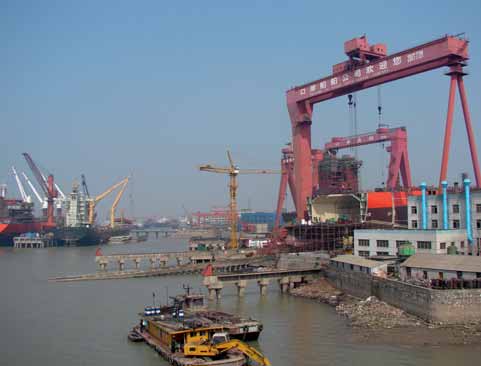Indian shipbuilders denied of government subsidy since 2007 suffer a cost disadvantage of up to 50% vis-à- vis their peers in China and to a lesser extent South Korea, which between them have a share of over 75% of global shipbuilding activity. In five years since the withdrawal of subsidy of 30% of ship cost, Indian industry’s share of world order book for vessels shrank to 0.04% from 1.3%, wiping out all the gains that the incentive bequeathed during 2002/07. It is in this context and also because of slowing down in growth of international trade, euro zone slipping into recession for second time in four years and shipbuilders in China and South Korea competing hard for new orders, including offers of discount, the Indian shipping ministry’s projection of the industry here raising its share of global ship construction market to 5% by 2020 looks unachievable. Shipping ministry officials, however, say that in case the government would accept its recommendation to reintroduce subsidy for shipbuilding though at a lower rate than earlier along with other fiscal incentives, conditions will be created for its rapid growth once again.

This is not the first time, however, that the ministry is making an attempt to convince the government of the compelling reasons for subsidy restoration though at half the earlier rate. While proposing a subsidy of 15% on prices of vessels built at local public and private sector yards, the ministry must have taken into account the untenable fiscal deficit that the country is facing and government resolution, therefore, to prune subsidy on many sensitive items like fertilizers and food. The ministry hopes to convince the government that unless local shipyards are enabled to compete with their counterparts in other two Asian countries, the industry here will not attract new investments and yards in operation will not have reasons to add capacity. In fact, during the shipping boom, which ended with the world getting hit by memory’s most savage recession in 2008/09, India’s shipbuilding industry received investment proposals amounting to well over $7 billion. While quite a few leading Indian business houses had their plans ready to build shipyards, only the engineering group Larsen & Toubro and SKIL Infrastructure have finally created facilities for shipbuilding in recent years. What held back others was their belief that without “adequate incentive that alone could create a level playing field in a fiercely competitive industry getting more and more concentrated in South Korea and China,” their investments were more than likely to turn sour.
While the above shows investment stagnation in the industry, local shipyards denied of subsidy are remaining silent witness to Indian shipping companies placing orders for new vessels with builders in China and South Korea.According to the UK based Clarkson Research, in 2011 South Korea received orders for new ships worth $48 billion and China $19 billion in 2011. Against these, Indian shipyards managed to garner orders worth $250 million only. In justification of the need to improve the competitiveness of the Indian industry, shipping ministry says in a paper:“Since the growth in orders to Indian shipyards is lagging behind the growth in global orders and needs immediate impetus to improve the weak order-book position, it needs to be considered whether a renewed subsidy scheme providing initially about 15% subsidy on the price of the ship to Indian shipyards may be introduced. However, in order to promote indigenization in shipbuilding, the subsidy may be linked to sourcing of at least 50% materials and components in terms of cost from domestic suppliers, so that there is growth of ancillary industries as well.”
A spokesperson of Confederation of Indian Industry (CII) told DCI that creating conditions for shipbuilding industry to achieve 50% local sourcing of components presents a “chicken and egg syndrome as we earlier saw in the case of automobile industry. Man, Rolls Royce and Wartsila of the world will create and expand their production base in India only when the mother shipbuilding industry here has attained ideal size and sophistication. Ideally, to start with the government should extend subsidy to ships built here irrespective of percentage of foreign origin components used. Maybe for the first five years of new subsidy regime, the industry should be exempted from the obligation of 50% local equipment use.” Shipbuilders have, however, welcomed the ministry proposal to end duty free import of ships from foreign shipyards in favour of a suitable WTO complaint import duty.The ministry wants a 5% duty on import of ships.
The combination of subsidy and import duty on ships should boost shipbuilding activity in the country. Incidentally, in their early stages of growth, both South Korean and Chinese yards received many kinds of government support. They still are beneficiaries of generous government support. In the meantime,taking a leaf out of an established practice in some countries, including the US, Indian shipping ministry wants the government to make it a condition that only locally built ships and not just locally registered ships irrespective of their origin will be allowed to ferry cargoes on coastal routes. India having a long coastline of 7,516km, it is only natural that coastal trade will continue to grow rapidly.
By Kunal Bose in Calcutta